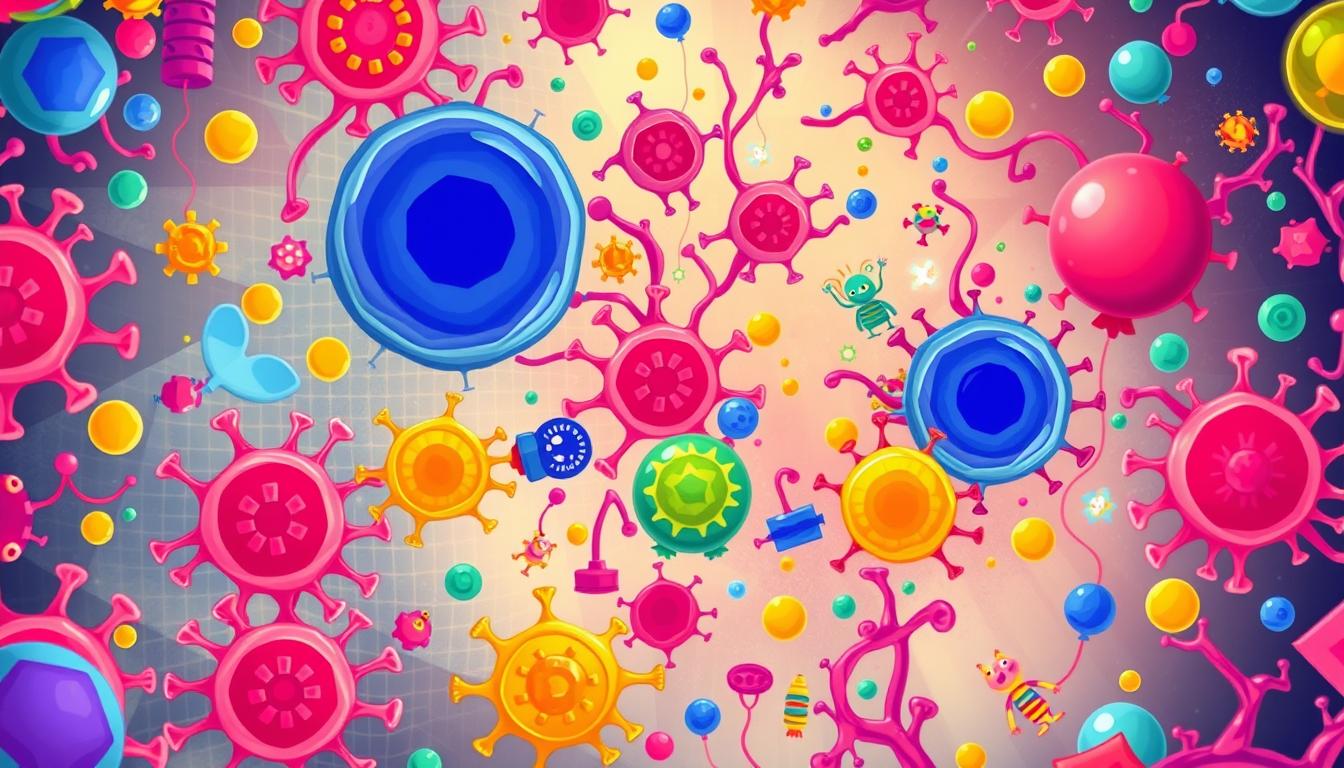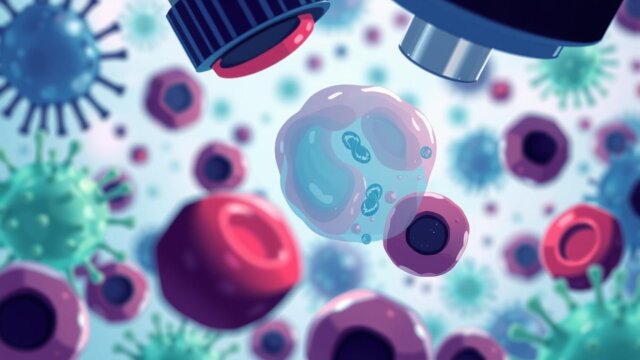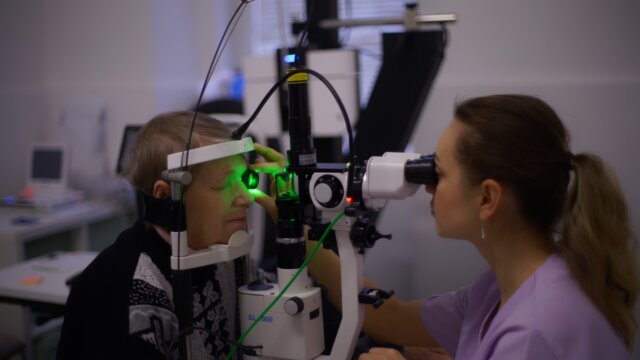FTC disclaimer: This post may contains affiliate links and we will be compensated if you click on a link and make a purchase.
Neuroblastoma is a rare and aggressive cancer. It affects about 650 kids in the U.S. each year. This disease mainly hits nerve tissue in babies and young kids. It often starts in the belly, adrenal glands, or other body parts.
It’s the top cancer outside the brain in kids. Most cases happen in children under five.
Key Takeaways
- Neuroblastoma is a rare and aggressive type of childhood cancer that primarily affects children under the age of 5.
- The disease typically originates in the nerve tissue of the abdomen, adrenal glands, or other areas of the body.
- Neuroblastoma is the most common extracranial solid tumor of childhood, with approximately 650 cases diagnosed in the United States each year.
- Neuroblastoma can spread quickly and metastasize to other parts of the body, making it a challenging disease to treat.
- Early detection and comprehensive, multimodal treatment approaches are crucial for improving outcomes for children with neuroblastoma.
What is Neuroblastoma?
Defining Neuroblastoma
Neuroblastoma is a cancer that starts from early nerve cells called neuroblasts. These neuroblasts are found in the fetus and grow wrong due to a genetic change. It often spreads to other parts like the lymph nodes, liver, bones, and bone marrow. It’s the most common cancer in kids outside the brain.
It usually starts in the adrenal glands, which are the most common place for it to start. Symptoms include a lump in the belly, neck, or chest, bulging eyes, bone pain, and weakness or paralysis. Doctors use x-rays, CT scans, ultrasounds, MRIs, and MIBG scans to find it. Treatment options include surgery, radiation, chemotherapy, and more.
| Key Facts about Neuroblastoma |
|---|
| Neuroblastoma most commonly begins in the tissues of the adrenal gland in the abdomen. |
| In the United States, approximately 800 new cases of neuroblastoma are diagnosed each year. |
| Neuroblastoma is found slightly more often in boys than in girls. |
| High-risk neuroblastoma accounts for about half of all neuroblastoma cases. |
| In the United States, there are approximately 600 children diagnosed with neuroblastoma each year. |
| Neuroblastoma is the most common tumor found in children under 1 year old. |
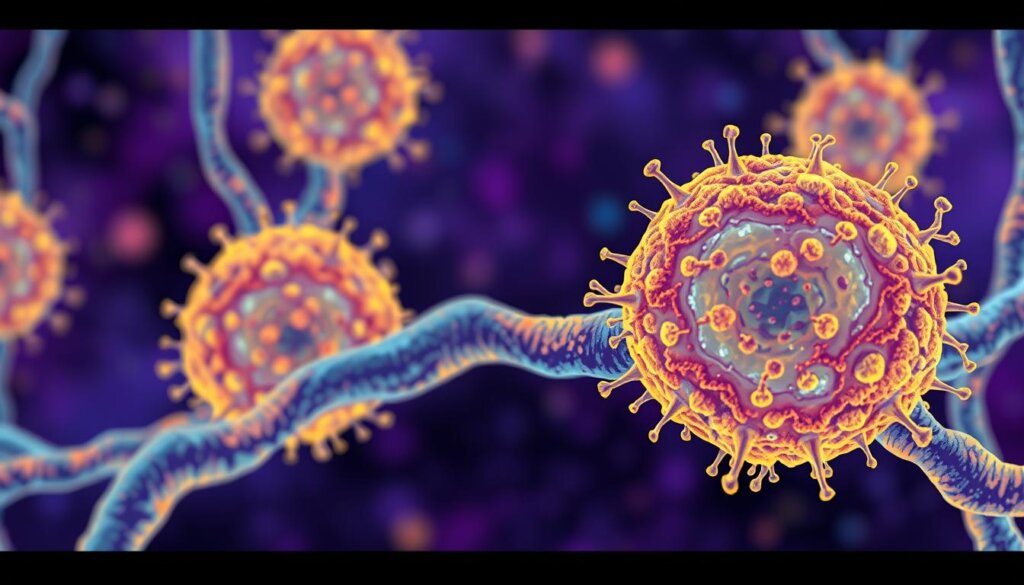
“Neuroblastoma is a complex and challenging childhood cancer that requires a multidisciplinary approach to treatment.”
Causes and Risk Factors
The exact cause of neuroblastoma is still unknown. It is thought to start from an early nerve cell in the fetus. This cancer is rare in kids, making up 8% to 10% of all childhood cancers.
About 80% of cases happen in kids under 5, with most diagnosed at 2.5 years old. It’s very rare in people over 10.
In some cases, a family history of the disease can increase the risk. This is due to genetic changes, like in the ALK gene. Around 1% to 2% of kids with neuroblastoma have a family history.
Children with certain genetic conditions are also at higher risk. These include Hirschsprung’s disease and Neurofibromatosis type 1.
Research is looking into if exposure to toxins during pregnancy can cause neuroblastoma. Maternal medication use and diet may also increase the risk.
Lifestyle choices like diet and smoking are not big factors in childhood cancers.
In summary, genetic mutations, especially in the ALK gene, are the main causes of neuroblastoma. Inherited conditions also play a role. Environmental factors and maternal exposures during pregnancy might also be involved. But more research is needed to understand these causes fully.
Symptoms of Neuroblastoma
Common Signs and Symptoms
Neuroblastoma is a childhood cancer with many symptoms. These depend on the tumor’s size, location, and spread. Common signs include an abdominal mass, swelling around the eyes, and unexplained fevers.
Bone pain, limping, and weakness or paralysis are also common. Other symptoms include weight loss, poor appetite, and uncontrolled movements. High blood pressure, increased heart rate, flushing, and diarrhea are also symptoms.
Tumors in the abdomen or pelvis can cause a large lump and weight loss. They can also affect fluid circulation, leading to swelling in the legs or scrotum. Tumors in the chest or neck may cause visible lumps and breathing or swallowing problems.
Neuroblastoma can spread to lymph nodes, causing swelling in areas like the neck or groin. This can mimic infection symptoms. When it spreads to bones, it can cause pain, limping, and spinal cord compression.
Bone marrow spread can lead to fatigue, weakness, infections, and bleeding. Neuroblastoma can also cause hormone release, leading to diarrhea, fever, high blood pressure, and rapid heartbeat. A specific form, Stage 4S neuroblastoma, is treatable and often resolves on its own.
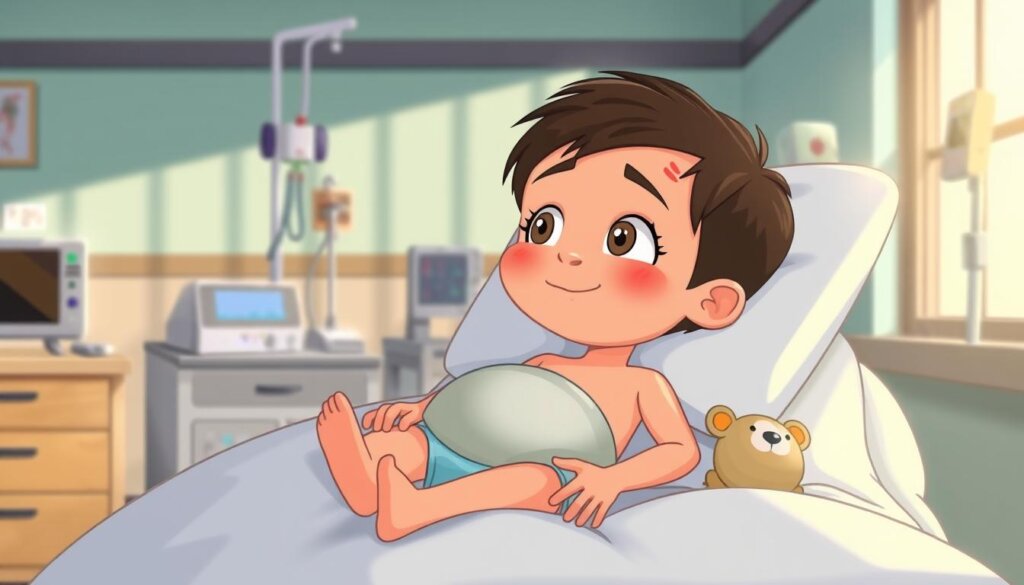
Neuroblastoma most often affects children aged 5 or younger. Some forms go away on their own, while others need multiple treatments.
Diagnosis and Staging
Diagnosing neuroblastoma takes many tests and steps. The International Neuroblastoma Risk Group Staging System (INRGSS) uses CT or MRI and MIBG scans to find the stage before treatment starts. It groups neuroblastomas into 4 stages: L1, L2, M, and MS (Metastatic disease in children younger than 18 months).
The International Neuroblastoma Staging System (INSS) looks at surgery results. It’s not used to find the stage before treatment. INSS stages include Stage 1, 2A, 2B, 3, 4, 4S, and Recurrent (cancer that has come back after treatment).
Other markers like age, tumor type, DNA, MYCN gene, and receptors also help predict a child’s outcome. Blood tests for ferritin and lactate dehydrogenase (LDH) also predict how well a child will do.
Diagnostic Test | Purpose |
|---|---|
Blood tests | Measure levels of certain substances, such as hormones that may indicate the presence of neuroblastoma. |
Urine and plasma catecholamine tests | Detect elevated levels of hormones produced by neuroblastoma cells. |
Imaging studies (ultrasound, CT scan, MRI, MIBG scan) | Evaluate the primary tumor and detect any metastases. |
Bone marrow biopsy or aspiration | Examine the bone marrow for the presence of neuroblastoma cells. |
These tests and procedures help doctors accurately diagnose and stage neuroblastoma. This is key for creating the right treatment plan. UT Southwestern Medical Center has a lot of experience in treating neuroblastoma. They offer a detailed approach to diagnosis and staging.
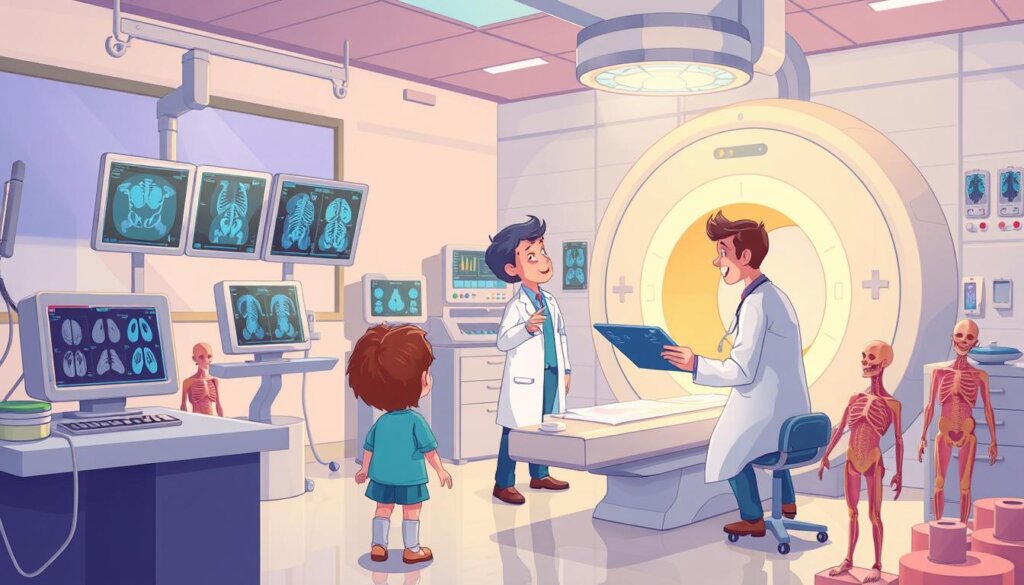
“Accurate diagnosis and staging are essential for determining the most effective treatment approach for each child with neuroblastoma.”
Neuroblastoma Stages
Neuroblastoma is a complex childhood cancer. It is classified into different stages using the International Neuroblastoma Staging System (INSS). This helps doctors choose the right treatment and predict the outcome for each patient.
Stage I neuroblastoma is a tumor that can be removed by surgery. Stage II tumors are in the same area but can’t be fully removed. Stage III tumors are big and spread across the middle of the body. Stage IV tumors have spread to distant places like lymph nodes, bone marrow, bones, liver, or other organs.
There’s a special stage, Stage IVs, for kids under 1 with small tumors that have spread to the liver, skin, or bone marrow. These cases often need little to no treatment and can do well.
The International Neuroblastoma Risk Group (INRG) also classifies neuroblastoma. It’s divided into localized (L1 or L2), metastatic (Stage M), and Stage MS. Low-risk neuroblastoma is common in infants and has small, easy-to-remove tumors. Intermediate-risk cases have larger tumors or spread in kids under 18 months. High-risk neuroblastoma is harder to treat and includes the spread of disease after 18 months or tumors with MYCN amplification.
Knowing the stages of neuroblastoma is key to choosing the right treatment and predicting the outcome. New therapies and research are improving the outlook for kids with this disease.
Neuroblastoma Stage | Characteristics |
|---|---|
Stage I | Tumor confined to the area of origination; complete removal possible by surgery. |
Stage II A | Tumor confined to the area of origination but cannot be fully removed by surgery. |
Stage II B | Tumors confined to the area of origination may not be fully removable by surgery, and they may be present in adjacent lymph nodes. |
Stage III | Tumors are not fully removable by surgery and are spread to the other side of the body or to lymph nodes of both sides. |
Stage IV | Spread to distant lymph nodes, bone marrow, bones, liver, or other organs. |
Stage IV S | Applicable only to children under one year, tumor confined to the area of origination but cells spread to liver, skin, or bone marrow. |
“Neuroblastoma is the most common tumor of the sympathetic nervous system, accounting for 97% of such cases.”
Treatment Options
Neuroblastoma treatment often uses many therapies together. This helps manage this childhood cancer. The plan might include surgery, chemotherapy, and more.
Multimodal Approach
Low-risk neuroblastoma might need less treatment. But, high-risk cases need a stronger plan.
- Surgery is used to remove tumors.
- Chemotherapy uses drugs like carboplatin and doxorubicin.
- Radiation targets any leftover cancer cells.
- Stem cell transplant is used for high-risk cases.
- Biologic and MIBG therapies are new ways to fight cancer.
The treatment plan is made just for each patient. Clinical trials help find better treatments.
“The treatment of neuroblastoma is complex and often involves a combination of therapies. The specific approach is customized for each patient based on their individual needs and the stage of the disease.”
Relapsed or Refractory Neuroblastoma
Neuroblastoma is a tough childhood cancer. It starts in young nerve cells. About 10% to 15% of kids with high-risk neuroblastoma don’t get better with first treatment. This is called refractory neuroblastoma.
Also, 40% to 50% of kids with neuroblastoma might have their cancer come back after they seem to get better. This makes treating relapsed or refractory neuroblastoma very hard for doctors and families.
Doctors are trying hard to make treatments better. They want to help more kids live longer and avoid bad side effects. They’re testing new treatments in clinical trials.
MIBG therapy is one new treatment. It uses special radiation to kill cancer cells. But, it needs a special room because it’s so radioactive. Only a few hospitals can do it.
Doctors might suggest new treatments like chemotherapy, antibody therapy, or MIBG therapy for kids with relapsed or refractory neuroblastoma. Studies show that 25-31% of kids with relapsed or refractory neuroblastoma need more study. Some kids can live a long time without their cancer coming back after getting the right treatment.
Every child with relapsed or refractory neuroblastoma gets a treatment plan that’s just for them. By trying new treatments and joining clinical trials, doctors aim to help these kids get better and live well.
Statistic | Value |
|---|---|
Refractory Neuroblastoma | 10-15% of high-risk cases |
Relapsed Neuroblastoma | 40-50% of cases |
Outcomes Requiring Further Study | 25-31% of relapsed/refractory cases |
MIBG Therapy | Targeted radiation therapy for relapsed/refractory neuroblastoma |
The goal for kids with relapsed or refractory high-risk neuroblastoma is to get better and live well. Doctors are looking at new treatments and plans that are just for each child. They want to help these kids beat this tough cancer.
Prognosis and Survival Rates
The outlook for kids with neuroblastoma varies a lot. It depends on how far the disease has spread, the tumor’s size and where it is, and the cancer cells’ type. Kids with low-risk neuroblastoma have a good chance of living long, with over 90% surviving. But, kids with high-risk neuroblastoma face a tougher road, needing more intense treatment.
The Children’s Oncology Group (COG) has risk groups for neuroblastoma. Low-risk has a 95% 5-year survival rate. Intermediate-risk is around 90% to 95%. Sadly, high-risk has a 50% 5-year survival rate. Overall, 68% of kids under 15 survive 5 years.
Age is key in neuroblastoma. Kids under 1 have a 95% 5-year survival rate. But, kids over 18 months face a higher risk of relapse. Neuroblastoma in adults is very rare, with much lower survival rates.
Other factors like the disease stage and tumor biology also matter. Stage 4S neuroblastoma has a 90% survival rate. But, 50% to 60% of high-risk patients relapse, often within 2 years.
Treatment for neuroblastoma has gotten better over time. In Germany, the 10-year survival rate for stage 4 neuroblastoma in kids over 18 months went from 2% to 38%. Yet, neuroblastoma is still a tough childhood cancer. More research is needed to help kids survive better.
Neuroblastoma Research and Clinical Trials
Ongoing neuroblastoma research and clinical trials are key to fighting this tough childhood cancer. Researchers are looking into new ways to treat it. This includes targeted therapies, immunological approaches, and stem cell transplants.
Places like Cincinnati Children’s are leading in neuroblastoma research. They offer patients chances to try new treatments in clinical trials. These trials aim to find safer and more effective treatments.
- Studies show DNA changes on chromosome 6 (6p22) are common in aggressive neuroblastomas.
- Older kids with neuroblastoma often have changes in the ATRX gene. This means their tumors grow slower but are harder to cure.
- Genetic changes in ALK and MYCN genes help figure out a child’s risk group.
- Two stem cell transplants (tandem transplants) are better than one for high-risk neuroblastoma.
Researchers are also looking at retinoids, like 13-cis-retinoic acid (isotretinoin), for high-risk neuroblastoma. They think it might work better with certain immunotherapies. Drugs targeting the Aurora A kinase pathway are also being studied.
Monoclonal antibodies like dinutuximab (Unituxin) are used for high-risk neuroblastoma. CAR T-cell therapy targeting GD2 on neuroblastoma cells is also being tested.
Survival rates for high-risk neuroblastoma are not as good as for lower-risk cases. But, new trials are looking at immunological approaches and targeted therapies to help.
Joining clinical trials can give patients access to the newest treatments. Families can work with doctors to find the best trial for their child.
“The progress we’ve made in treating neuroblastoma is a testament to the dedication and hard work of researchers and clinicians worldwide. While there is still much to be done, these clinical trials offer hope for even better outcomes in the future.”
Follow-up Care and Survivorship
Long-term Monitoring and Support
Children treated for neuroblastoma need ongoing care. They must be watched for disease return and side effects from treatment. The effects of treatment can vary based on the therapy and the child’s age.
Most survivors of high-risk neuroblastoma face mild to moderate side effects. The care team offers support and services like nutrition and psychology help. Survivors can find detailed care guidelines at www.survivorshipguidelines.org.
Survivors should focus on preventing second cancers and managing school issues. They also need to find healthcare and deal with emotional concerns.
Neuroblastoma survivors might face hearing loss, thyroid issues, and growth problems. It’s key to attend all follow-up visits to watch for cancer return. Initial visits include many tests for recurrence.
Follow-up care is a chance to ask questions and share concerns. Care plans include exams and tests for other cancers. Keeping medical records is vital for future health.
There’s no clear diet to prevent neuroblastoma return. Healthy habits like not smoking and exercise are good for health. Talk to a doctor before taking supplements.
Pediatric cancer centers offer support for families. Family members face emotional and financial challenges. Support services help with these issues.
Conclusion
Neuroblastoma is a tough childhood cancer that needs a team effort for diagnosis, treatment, and care. It makes up 8%-10% of all childhood tumors. About 15% of all cancer deaths in kids are from this disease.
Every year, nearly 500 new cases of neuroblastoma are found in the U.S. This happens in about 10.2 cases per million kids under 15.
New research and treatments give hope to kids and families with neuroblastoma. Survival rates have gone up from 52% to 74% in 30 years. But, high-risk patients still face a 50-60% chance of relapse, with a 5-year survival rate of about 20%.
Knowing the facts about neuroblastoma helps parents and caregivers work with doctors for the best care. About 700-800 new cases are diagnosed in the U.S. each year, mostly in high-risk patients. Research and trials are key to finding better treatments and improving survival rates for all.
FAQ
What is neuroblastoma?
Neuroblastoma is a rare cancer in kids under 5. It grows in nerve tissue. It’s the most common tumor outside the brain in children.
What causes neuroblastoma?
It starts from a nerve cell in the fetus. A genetic mistake makes it grow wrong. Sometimes, a gene change, like in the ALK gene, can cause it.
What are the common symptoms of neuroblastoma?
Symptoms include an abdominal mass and swelling around the eyes. Kids might also have fevers, bone pain, and weakness. Other signs are weight loss, poor appetite, and uncontrolled movements.
How is neuroblastoma diagnosed?
Doctors use blood tests, urine tests, and imaging like CT scans. They also do bone marrow biopsies to diagnose it.
What are the different stages of neuroblastoma?
The INSS system has stages like Stage I to Stage IVs. Each stage shows how far the disease has spread.
What are the treatment options for neuroblastoma?
Treatments include surgery, chemotherapy, and radiation. They also use stem cell transplants and biologic therapy. The plan depends on the stage and risk factors.
What happens if neuroblastoma relapses or becomes refractory?
About 50% of kids with high-risk neuroblastoma relapse. 15% have disease that doesn’t respond to treatment. Treatment is often tailored and might include clinical trials.
What is the prognosis for children with neuroblastoma?
Survival depends on the disease’s extent and the tumor’s size. Low-risk cases have better chances, but high-risk ones face tougher odds.
What is the importance of research and clinical trials for neuroblastoma?
Research and trials are key to finding better treatments. They explore new therapies and ways to improve survival rates for kids with neuroblastoma.
What kind of follow-up care is needed for neuroblastoma survivors?
Survivors need ongoing care to watch for disease return or side effects. The neuroblastoma team provides support for the best outcomes.
